2024 Toyota Land Cruiser Review and Test Drive
The Land Cruiser returns as a smaller, less costly, retro-styled, and more utilitarian SUV.
 Jim Resnick
Jim Resnick
Toyota's Land Cruiser debuted in the United States in 1958 as a basic four-wheel-drive, Jeep-like tool. By 2021, it had grown into a large, leather-lined, luxe SUV just shy of a Lexus badge and tickled the $90,000 mark in price. Given its origin story, that '21 Land Cruiser exemplified automotive mission creep. At the end of that year, Toyota shelved it — temporarily, as it turns out.
With the redesigned 2024 Land Cruiser, Toyota has returned to the drawing board. It's a more basic SUV with a robust four-wheel-drive system and a lower price tag. Like the previous Cruiser, it still has a Lexus cousin, but this time it's the GX. A Toyota-badged sibling arrives soon as the redesigned 2025 4Runner.
The new 2024 Toyota Land Cruiser answers to several market realities. First, the old Land Cruiser felt too bulky and luxurious, particularly given the existence of the nearly identical Lexus LX. Second, Jeep's perennially popular Wrangler, Ford's recently reintroduced Bronco, and Land Rover's well-received Defender shifted the segment toward more elemental off-roaders.
Third, in my opinion, the Land Cruiser name still has great value. Wasting it would be a shame.
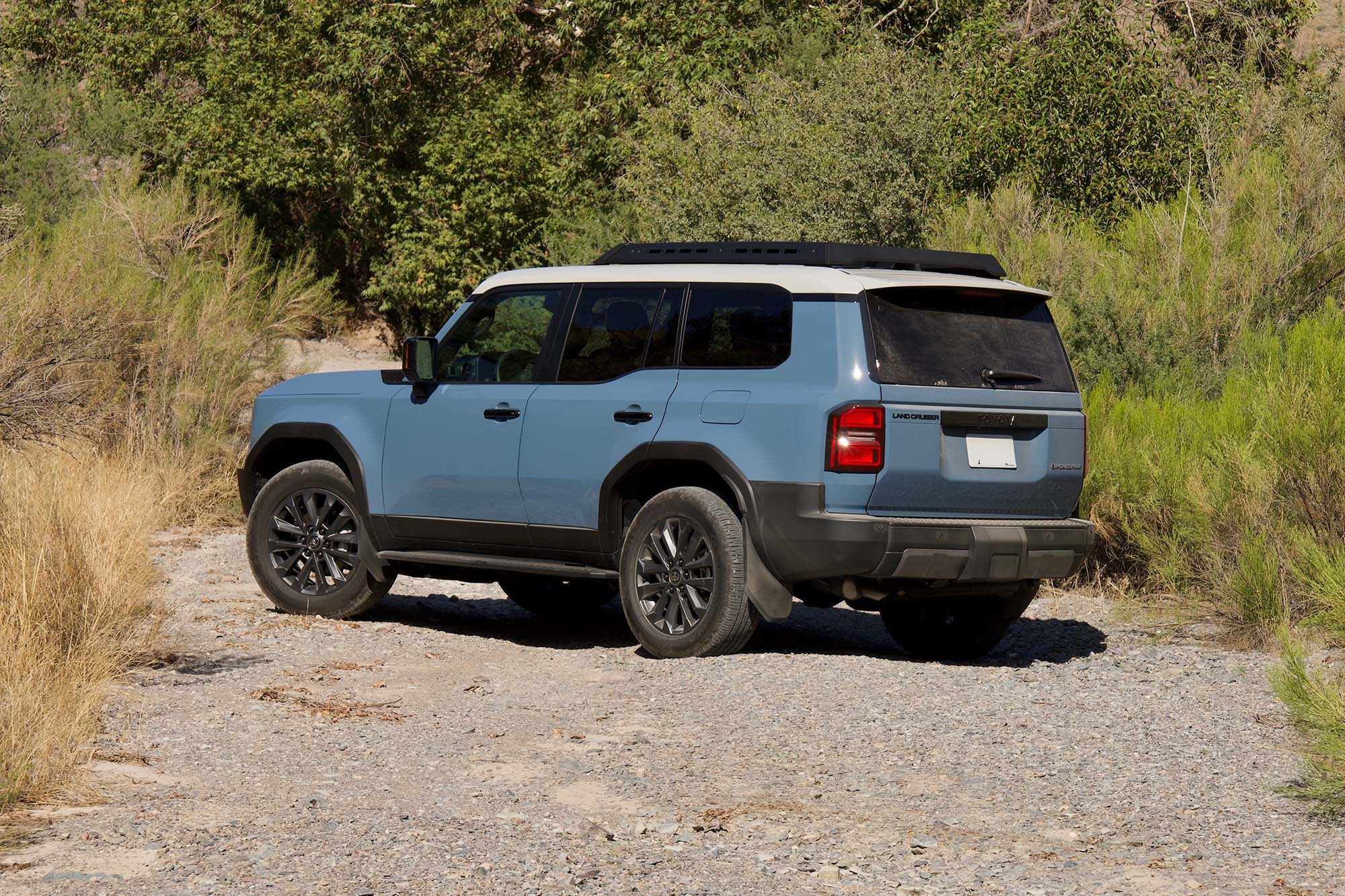 Jim Resnick
Jim Resnick
Prices Drop for the All-New 2024 Toyota Land Cruiser
The 2024 Toyota Land Cruiser comes in three trim levels. Toyota calls the base model 1958 (for the first year it sold the model in the U.S.), while the middle trim is simply called Land Cruiser and the top version is the First Edition.
Base prices range from the high $50,000s to the mid-$70,000s, including the destination charge to ship the SUV from the factory in Tokyo, Japan, to your local dealership.
For this Land Cruiser review, I test-drove the middle trim level variant in Arizona. Highlights from the optional equipment list include the Premium Package, 20-inch alloy wheels, a large roof rack, and white paint that nicely offset the Smoky Blue body color.
The manufacturer's suggested retail price of the test vehicle was $71,364, including the $1,395 destination charge. (The carmaker has since increased its destination charge to $1,450.) Toyota provided the vehicle for this Land Cruiser review.
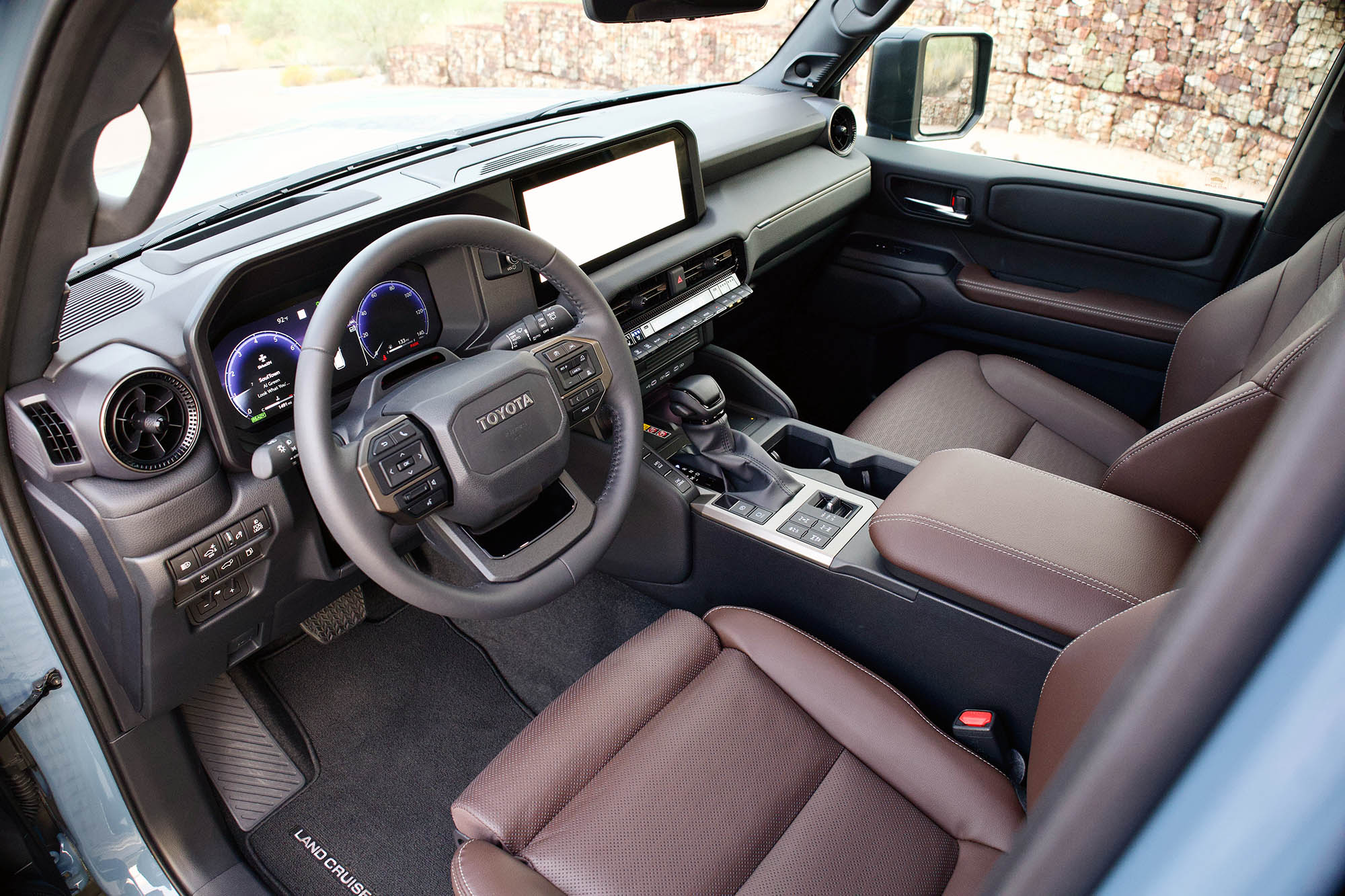 Jim Resnick
Jim Resnick
A Stylish, Boxy Exterior Makes This a Handsome Truck
The Land Cruiser isn't as distinctive as the Ford Bronco or Jeep Wrangler, instead presenting a more mature design. The round headlights on 1958 and First Edition models, the jaunty upkick at the rear door windows, and the available bright paint colors all add character, however.
High-grade interior plastics decorate the Land Cruiser's cabin, and the build quality is excellent. Some minor details are pleasing, too, such as the shape of the JBL audio system's tweeter housings.
That said, there's room for improvement. The rear seatbelts get in the way when you fold and tumble the second-row seats up and forward, for example. Also, the rear seats don't fold flat, so you can't create a flat-load floor in this SUV for cargo hauling or camping out in the back.
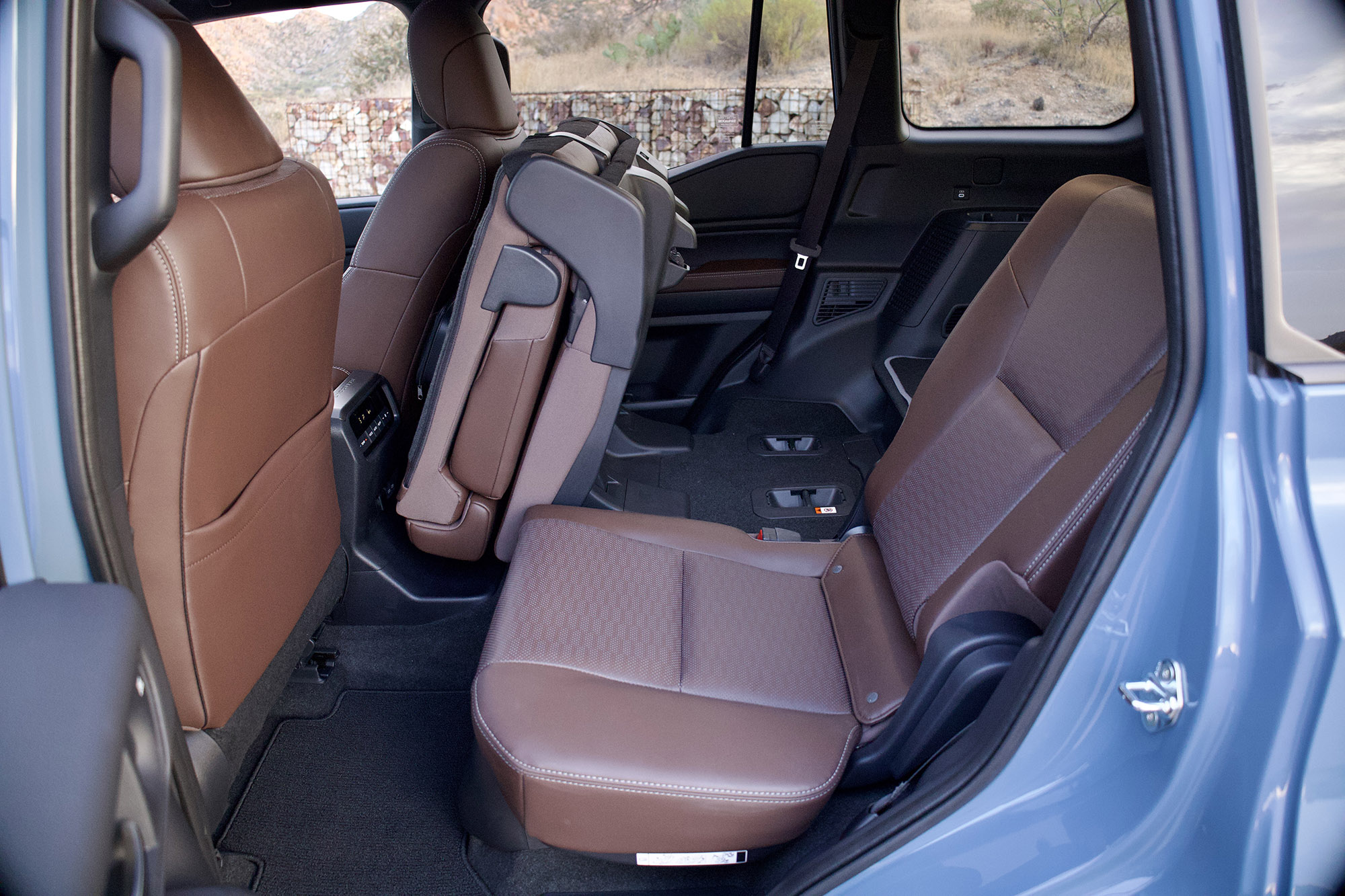 Jim Resnick
Jim Resnick
A Clean-Lined Interior Features Decadent Seats
The new Land Cruiser isn't as posh as the old Land Cruiser, but it's not exactly lacking. Where the base Land Cruiser 1958 comes with cloth seats, the middle-trim Land Cruiser has SofTex artificial leather or, as an option, the real thing. My test vehicle's medium-brown leather upholstery looked terrific, adding a hint of richness to the cabin.
Thanks to the large center console, there's a cozy, tucked-in feeling up front. The only real letdown I found was that the passenger seat doesn't have the same manually adjustable thigh bolster as the driver's seat.
The rear-seat room felt about average, with just enough space for my legs and knees as long as the front seats weren't at the far end of their travel. There's also decent headroom. Given that the Land Cruiser is very tall, though, you might expect there'd be more.
The Land Cruiser does not offer a third-row seat, which surprised me, because the Lexus GX provides one.
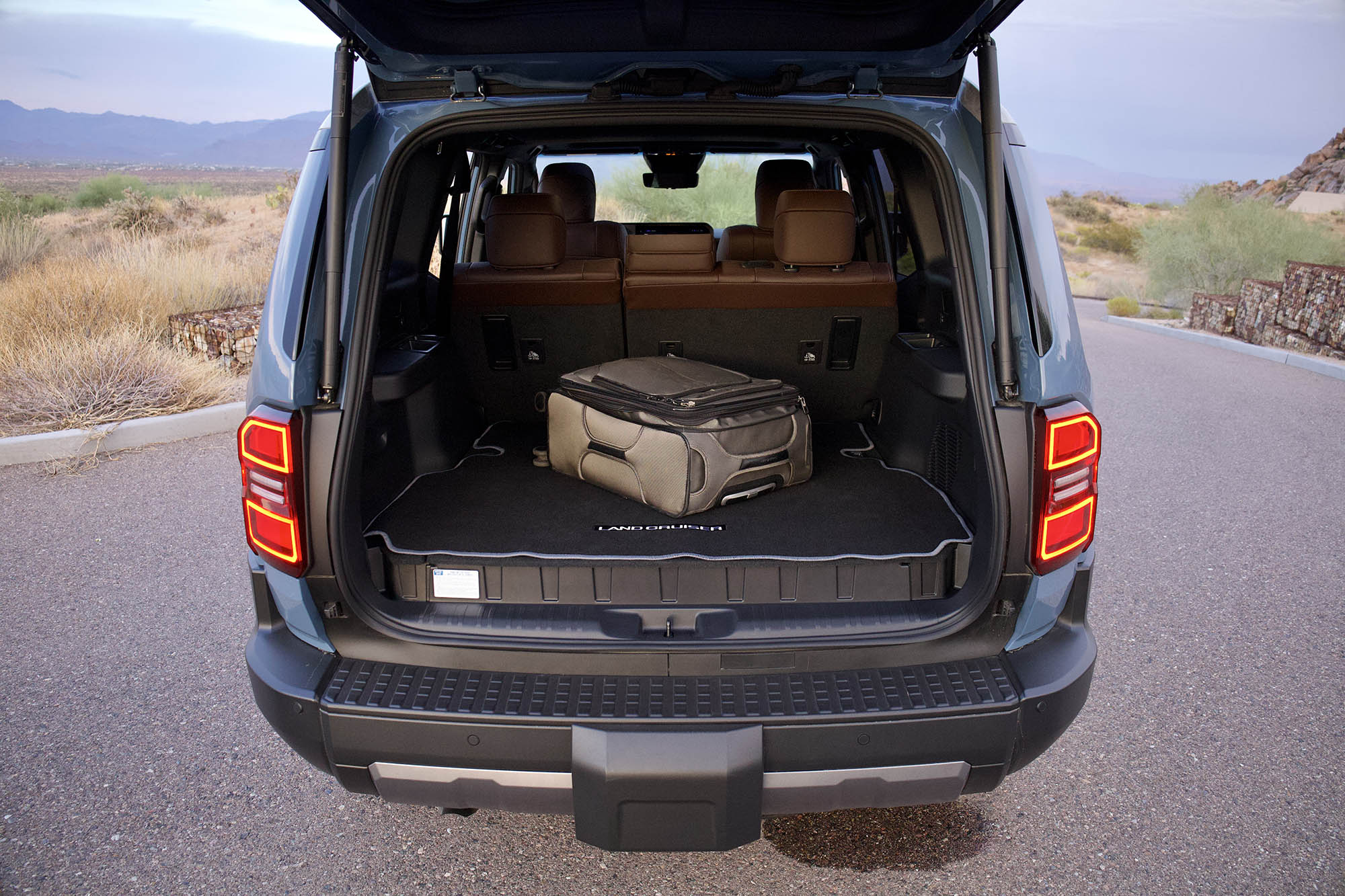 Jim Resnick
Jim Resnick
Acceptable Cargo Space Is Hampered by a High Floor
Since it doesn't have a third-row seat, it seems like the new Land Cruiser should provide a generous cargo area. It's by no means tiny, measuring 37.5 cubic-feet behind the rear seats, but the high cargo floor dictated by the hybrid powertrain's battery means loading objects requires more effort than with other SUVs. The Land Cruiser's high ride height accentuates that, too.
The test vehicle had a refrigerated cooler box perfect for stashing a few soda cans or a box of chocolates. However, it takes the place of the center console storage bin, and I missed that storage space more than I liked the mini fridge.
 Jim Resnick
Jim Resnick
Toyota Audio Multimedia Provides the Infotainment
Toyota equips the Land Cruiser with Toyota Audio Multimedia, the company's in-house infotainment system. The Land Cruiser 1958 includes an 8.0-inch touchscreen, but my midlevel test vehicle had a larger 12.3-inch display.
Wireless Apple CarPlay and Android Auto connectivity, SiriusXM satellite radio, and a 10-speaker sound system are standard. My test vehicle boosted that equation with an optional 14-speaker JBL audio package. This system performed exceptionally well, with excellent fidelity and strength in the bass department.
Connecting my iPhone via Bluetooth proved seamless and running CarPlay was no trouble. Upon returning to the vehicle, my device reconnected every time. The native voice recognition — alerted with a firm "Hey, Toyota" — could find tricky business names that sometimes flummox other systems. It also usefully notes whether a chosen business is open or closed at the time of the search.
 Jim Resnick
Jim Resnick
The Head-Up Display Highlights Key Info
The new Land Cruiser's instrument cluster is fully digital and configurable, offering detailed information that I found easy to reference. There are two options for presenting the instruments: conventional dial gauges or a simple slate of data.
My test vehicle's head-up display repeated the most vital information in my line of sight, including road speed, speed limit, and navigational graphics when active. As part of the optional Premium Package, a digital rearview camera mirror offers a clear view to the rear, so luggage stacked to the rafters inside the cargo area won't block the view.
 Jim Resnick
Jim Resnick
Toyota Safety Sense 3.0 Comes in Every Land Cruiser
Every 2024 Land Cruiser has Toyota Safety Sense 3.0 (TSS 3.0), a collection of advanced driver-assistance systems that equips the SUV with the features you likely expect in a modern vehicle.
On the freeway, the Land Cruiser's adaptive cruise control never failed to see a leading car slow down, nor did it take more than a split second to recognize a merging vehicle in front. The adaptive cruise also brought the SUV to a complete stop when the car ahead did the same. Once traffic started moving again, I could simply press the cruise control's resume function to let it accelerate again.
In addition, the Land Cruiser's lane-centering assist performed nearly flawlessly. It had one unusual tendency to hug a yellow line on the driver's side through a construction zone on a freeway I frequently drive. I didn't feel this was horrible, though, because hugging the other side would have meant kissing tractor-trailers, an activity I prefer to avoid.
Lane-change assist is also part of TSS 3.0, where a tip of the turn signal initiates a lane change if the coast is clear. Calibrated conservatively, it requires plenty of clearance ahead and behind. The system also takes longer to execute a lane change than most drivers, I found, but that's understandable. Overall, I found it too lethargic to use regularly.
 Jim Resnick
Jim Resnick
Torque Aplenty, and the Hefty Land Cruiser Needs It
At the heart of the new Land Cruiser is a hybrid powertrain based on a turbocharged 2.4-liter four-cylinder engine. It makes a healthy 326 horsepower and a whopping 465 pound-feet of torque, and while that's down in power from the old V8-powered 2021 Land Cruiser, torque is far more critical in a heavy vehicle.
Most SUVs (even those with fantastic off-roading capabilities) will see more suburban pavement than red rock-lined trails of the Wild West. Toyota fits the Land Cruiser with cushy suspension tuning, mild Dunlop Grandtrek mud and snow tires, and lots of noise-abating insulation. It all equates to a quiet ride in tame, suburban environments.
 Jim Resnick
Jim Resnick
Controllable, Progressive, and Versatile Power
At 5,038 pounds, the Land Cruiser needs every bit of its 465 lb-ft of torque to get underway, and it does so smartly. This SUV isn't fast, but you can't complain about the acceleration. In the combustion world, a good V8 makes a glorious sound. What emanates from the new Cruiser's turbo hybrid four-cylinder can't match the old Cruiser's V8 voice, but it isn't rough, unrefined, or surly in the way some large-displacement fours can be.
The engine doles out power smoothly and controllably when off-roading, too. Throughout one afternoon in the dirty and rocky stuff, the Land Cruiser handled trails a bit beyond the scope of the standard tires, and the throttle's progressive nature proved spot-on for rough going. Disconnecting the front anti-roll bar (which I did via a button on the console) is probably overkill on anything but the ruttiest path, but I tried it out. It worked, and I harmed no wheels, running boards, or suspension links in the process.
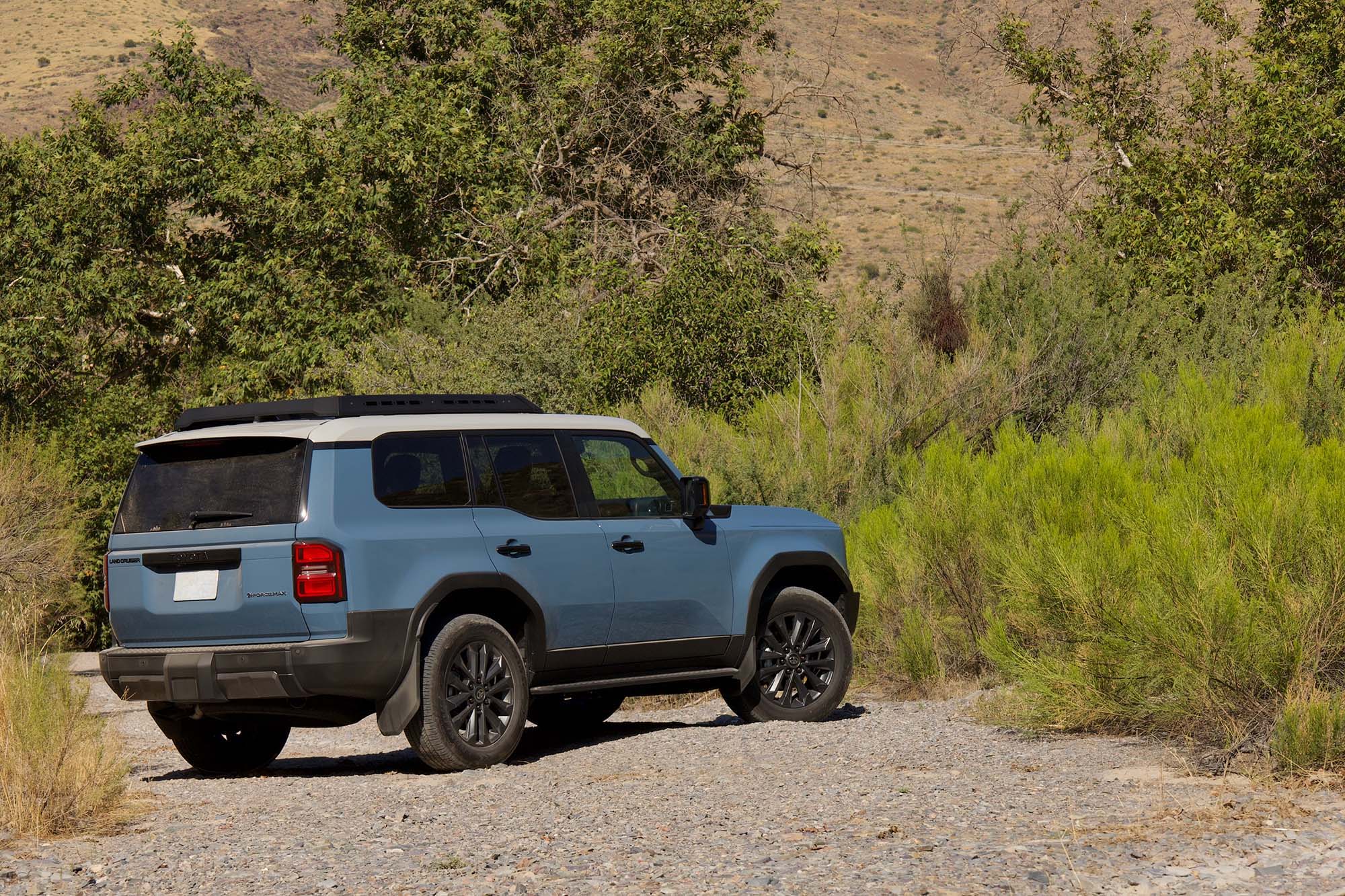 Jim Resnick
Jim Resnick
The Ride Can Feel Very Luxurious
The Land Cruiser wafts over highway pavement at least as well as it dispenses with rutty and rocky trails. The ride quality and impact harshness feel like what I might expect of a Lexus SUV, to a point.
The Toyota's truckier nature is evident on twisty roads. The grip is just middling, and there's lots of body lean in corners and nose-dive under braking. Actual braking power and effectiveness — separate from the body's reaction to brake application — is excellent, though.
At speeds above 75 mph, the Land Cruiser exhibits wind noise. However, this is inevitable given its tall stature, large side mirrors, and optional roof rack.
On my 73-mile loop of mixed freeway and suburban driving, the Land Cruiser logged a disappointing 20.5 mpg. It's disappointing because the EPA rates it at 22/25/23 mpg in city/highway/combined driving.
Worse, Toyota says the Land Cruiser is supposed to run on premium fuel. Between the observed fuel-economy shortfall and the extra cost of premium gas, owners may have to bear higher gas costs than anticipated.
 Jim Resnick
Jim Resnick
The Land Cruiser Offers Mixed-Use Opportunities
Compared with Land Cruisers of the past 15 years, the more popular 4Runner exemplifies the truly mixed-use 4x4 with its excellent off-roading capabilities and reputation for reliability.
Some family friction is likely to ensue.
Looking beyond the Toyota lineup, Land Rover's compelling Defender 110 is in a similar price league and has the same general mission as the Land Cruiser. And the Jeep Grand Cherokee is generally acknowledged to have excellent off-roading ability, everyday practicality, and plenty of creature comforts.
Regardless, I imagine what matters most to the fans of the brand is that the Land Cruiser is back in business. Better yet, it is more faithful to its original mission than it has been in a long time.
Written by humans.
Edited by humans.
 Jim Resnick
Jim ResnickFrom racing exotic sports cars, to ranking new cars, to peeling back layers of cover up in an exhaust emissions scandal, Jim has chronicled the automotive sector for decades. Jim has also worked inside the corporate headquarters of three carmakers, and therefore understands how the automotive sausage is really made. But Jim’s affinity for vehicles takes a back seat to finding the truth and the cultural implications of modern transportation. He has also lectured at universities to engineering and policy students and faculty on the industry’s relationship with legislation in the wake of the diesel exhaust emissions scandal several years ago. Put simply, Jim reports on autos, mobility, tech, car culture, and the traffic jam of topics within.
Related articles
View more related articles